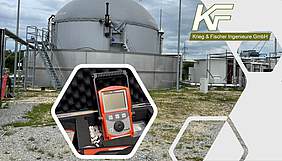The LÖNNE biogas plant is located in North Rhine-Westphalia and was neither planned nor built by us. After the bankruptcy of the manufacturing company, which had already carried out this work until 2021, we were commissioned with the completion and commissioning.
The aim of this plant is the mono-fermentation of fats and oils (fat separator contents from catering and food processing). Of course, fat waste has a very high biogas potential and the gas quality for combustion in combined heat and power plants is very advantageous due to the high proportion of methane (approx. 68-72%), and of course even more so when processed into biomethane. However, the high-water content in the grease separators can be problematic and lead to a fat-rich floating layer above the aqueous phase. As a rule, fats are not fermented mono-fermentation, but are added to the biogas plants as co-ferments to increase efficiency. These co-fermentation biogas plants run without problems and have often been built by us. For example, the Prince Edward Island biogas plant in Canada or Cassa de la Selva in Spain, to name but a few.
After an initial check-up, we asked ourselves the question: is mono fermentation of fat even possible and if so, how does it work? After carrying out continuous fermentation tests, we came to the following conclusion. Firstly, yes, it is possible and secondly, a minimally invasive intervention in this already built biogas plant is unavoidable. The following technical changes were therefore initiated and implemented before commissioning:
- The substrate must be heated
- The structure of the heating system must therefore be changed
- The above-ground substrate and gas pipes need frost protection
The biogas plant consists of a flat 600 cbm digester with a gas roof and submersible mixers on the sides. Two CHP units with an output of 150 kW are available, one of which is in reserve. Commissioning started in February, inoculation was carried out with an inoculum and then the substrate was slowly fed in. The gas is analysed using a gas detector; the gas is combustible from a methane content of approx. 50%. Only then can the combined heat and power plant go into operation.
The gas flare is now in operation. The CHP units are also already running on an hourly basis because not enough gas has yet been produced for continuous operation. This will be the case in the next few weeks.



